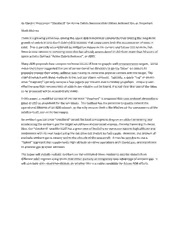
NASA Technical Reports Server (NTRS) 20130013760: An Electric Propulsion "Shepherd" for Active Debris Removal that Utilizes Ambient Gas as Propellant PDF
Preview NASA Technical Reports Server (NTRS) 20130013760: An Electric Propulsion "Shepherd" for Active Debris Removal that Utilizes Ambient Gas as Propellant
An Electric Propulsion “Shepherd” for Active Debris Removal that Utilizes Ambient Gas as Propellant Mark Matney There is a growing consensus among the space debris technical community that limiting the long‐term growth of debris in Low‐Earth Orbit (LEO) requires that space users limit the accumulation of mass in orbit. This is partially accomplished by mitigation measures for current and future LEO systems, but there is now interest in removing mass that has already accumulated in LEO from more than 50 years of space activity (termed “Active Debris Removal”, or ADR). Many ADR proposals face complex technical issues of how to grapple with uncooperative targets. Some researchers have suggested the use of conventional ion thrusters to gently “blow” on objects to gradually change their orbits, without ever having to come into physical contact with the target. The chief drawback with these methods is the cost per object removed. Typically, a space “tug” or an ion‐ drive “shepherd” can only remove a few objects per mission due to limited propellant. Unless a cost‐ effective way that removes tens of objects per mission can be found, it is not clear that any of the ideas so far proposed will be economically viable. In this paper, a modified version of the ion‐drive “shepherd” is proposed that uses ambient atmospheric gases in LEO as propellant for the ion drives. This method has the potential to greatly extend the operational lifetime of an ADR mission, as the only mission limit is the lifetime of the components of the satellite itself, not on its fuel supply. An ambient‐gas ion‐drive “shepherd” would the local atmospheric drag on an object by ionizing and accelerating the ambient gas the target would have encountered anyway, thereby hastening its decay. Also, the “shepherd” satellite itself has a great deal of flexibility to maneuver back to high altitude and rendezvous with its next target using the ion drive not limited by fuel supply. However, the amount of available ambient gas is closely tied to the altitude of the spacecraft. It may be possible to use a “hybrid” approach that supplements high‐altitude ion‐drive operations with stored gas, and transitions to ambient gas at lower altitudes. This paper will include realistic numbers on the estimated times needed to deorbit objects from different orbit regimes using drives that either partially or completely take advantage of ambient gas. It will conclude with recommendations on whether this is a viable candidate for future ADR efforts.
